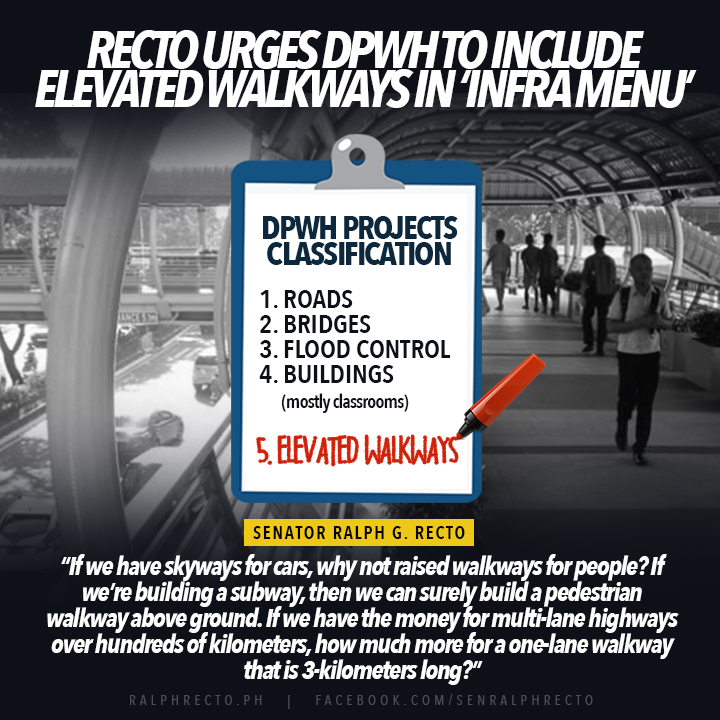Make elevated walkways part of infra menu–Recto
From just four types, a senator is pressing the Department of Public Works and Highways (DPWH) to debut next year a fifth – elevated walkways – in its infrastructure menu.
“It is time to elevate wide pedestrian and bike lanes, whether ground-level or elevated, to the league of major construction works,” Senate President Pro Tempore Ralph Recto said.
At present, DPWH projects can be grouped into four: roads, bridges, flood control, and buildings, the latter mostly classrooms.

Government’s infrastructure and spending plans are silent on elevated walkways, Recto said. “They do not even merit a footnote. The policy bias is for people who ride in cars but not for people who walk or bike,” he said.
“For example, in the budget request of the DPWH for 2019, projects sought to be funded were detailed in 1,030 pages of fine print, covering at least 20,000 funding items, but not one was for an elevated walkway,” Recto said.
Recto said it is time for government to build elevated walkways along the “pedestrian-dense” streets of urban centers like Metro Manila “to respond to the reality that more people are now walking to short distance destinations.”
“If there are no sidewalks, or if there are but they’re occupied, or are dangerous to walk on, then we should follow the best practice in many cities of building covered, all-season, and safe elevated walkways,” Recto said
Building them do not pose an engineering challenge, and cost-wise are affordable, Recto said.
“If we have skyways for cars, why not raised walkways for people? If we’re building a subway, then we can surely build a pedestrian walkway above ground. If we have the money for multi-lane highways over hundreds of kilometers, how much more for a one-lane walkway that is 3-kilometers long?”
Recto said a forthcoming $100 million loan from the Asian Development Bank for a greenways project covering six to seven walkways in North Edsa, Ortigas and Taft intersections, when implemented, should demonstrate the benefits of this kind of infrastructure.
“Pero dapat hindi lang mall-to-mall ang network of walkways. Lalabas kasi na parang interconnectivity of shopping centers. Itayo din ito doon sa mga lugar ng masa tulad ng Tondo, Sampaloc, at Commonwealth area sa Quezon City,” Recto said.
In the government’s infrastructure “division of labor,” ports, airports and railways are undertaken by the Department of Transportation; irrigation by the Department of Agriculture; and hospital and health facilities by the Department of Health.

